When you first start SooSL Desktop, you will probably see a blank screen with the Tools menu open in the upper right.
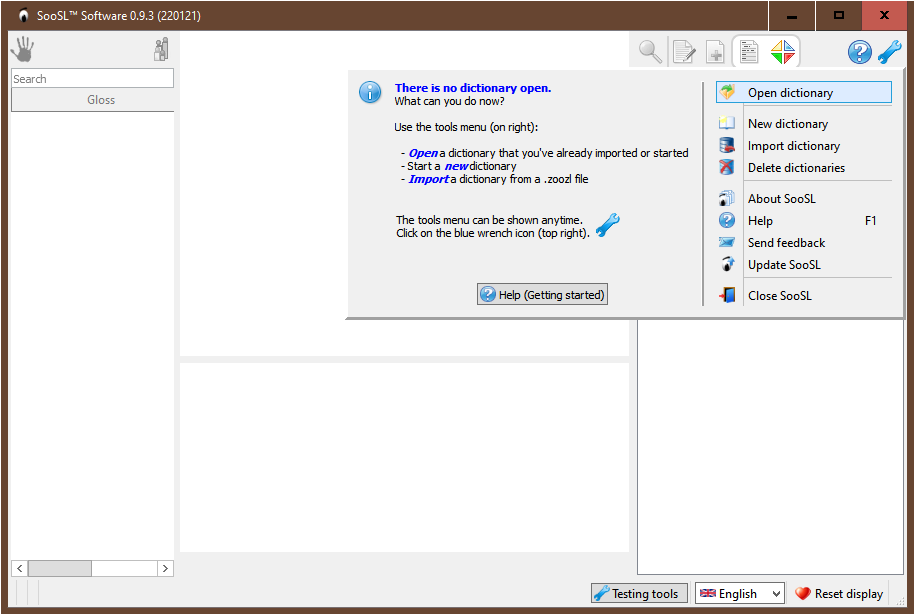
The screen is blank because you haven't opened a dictionary yet. You need to open a dictionary before you will see anything interesting. This help topic tells how to get your first dictionary and start using it in SooSL. (Later, you can make your own dictionary.)
The menu has suggestions about what you can do next. What do you do first? The easiest thing is to import a dictionary someone else has made. You will get it in a file called a ZooZL file. A ZooZL file has a .zoozl extension in its file name, like this:
____file name____.zoozl
For example: "Demo (ASL) 2020-12-29 (0.9.1).zoozl"
We use ZooZL files to move SooSL dictionaries from one computer to another. A ZooZL file contains all the individual files (videos, translations, etc.) that are needed for a dictionary, all packed into a single file. This makes it easy to move.
"Importing a dictionary project" means unpacking all the individual files from inside a ZooZL file into separate files that SooSL can work with. You have to import the dictionary from a ZooZL file into SooSL before you can see what is in it.
So, to start learning SooSL, it is good to import a ZooZL file. Here's what you do.
First, get a ZooZL file. It will contain a dictionary that someone else has made.
Save the ZooZL file to some convenient place on your computer—some place where you can find it again easily.
Next, start SooSL Desktop. (The way you start it is different on Windows, Mac, and Linux. See those help topics for instructions.)
After SooSL starts, it will ask you for the title of a dictionary project to open.
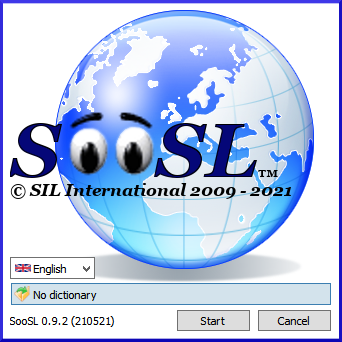
However, you can't open the ZooZL file quite yet; you have to import it first. So, it doesn't matter what project you choose to start with. If you are using SooSL for the first time, just leave the choice as "No dictionary". Click  .
.
After SooSL starts and you see the blank screen, you can import the dictionary. Click ![]() Tools. It is in the top-right corner of the SooSL window.
Tools. It is in the top-right corner of the SooSL window.

If the screen is completely blank, don't be discouraged! Just click on the ![]() Tools icon in the upper right corner to open the Tools menu.
Tools icon in the upper right corner to open the Tools menu.

Then, click ![]() Import dictionary.
Import dictionary.
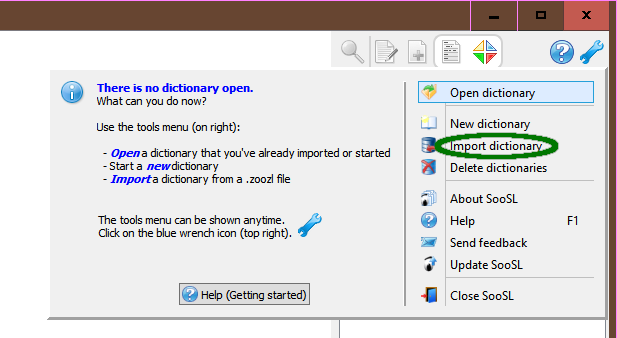
You will see a dialog like this.
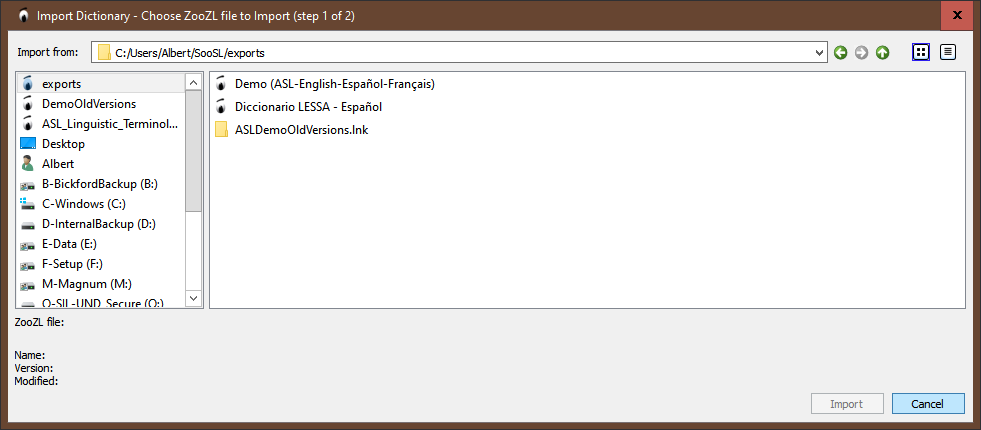
At the top, after "Import from:", it shows the path-name of a folder (directory). (Usually it will be the "exports" folder under your user SooSL folder.)
In the big area on the right, it shows the ZooZL files in that folder.
To look for a ZooZL file in a different folder, start with the list of folders on the left. It includes generic locations like your desktop folder or your hard drive(s). Click a folder or drive name on the left. The "Import from:" box will change to the path-name for that folder, and on the right you will see any ZooZL files in that folder. You will also see any sub-folders. To change to one of those sub-folders, double-click on it, or choose it and click  . Or, you can type a folder name after "Import from:" at the top. Finally, you can also use the arrows at the top right to move around between folders.
. Or, you can type a folder name after "Import from:" at the top. Finally, you can also use the arrows at the top right to move around between folders.
The names that you see on the right are actually the titles of the dictionaries inside each ZooZL file, not the ZooZL file's name. Click on one of the titles. At the bottom, after the words "ZooZL file:", you'll see the ZooZL file's actual file name. The title and the file name are usually similar, but not the same. Sometimes the same dictionary title appears more than once in the list on the right; this means there are different versions of the same dictionary, in separate ZooZL files.
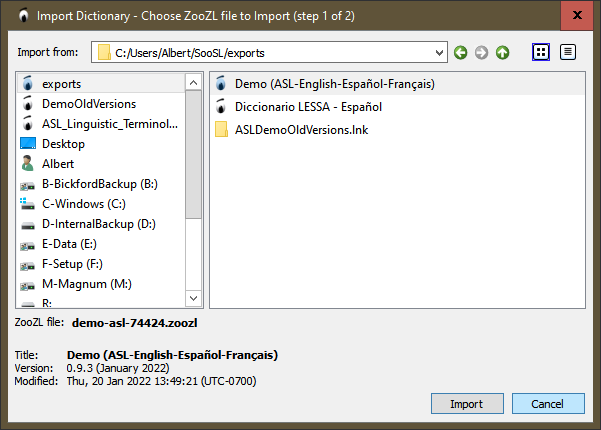
Also at the bottom, you can see the title of the currently selected dictionary, its version, and when it was last modified.
If you want to see more information about the different ZooZL files, including if you can change them, see detail view below.
When you find the ZooZL file you want, click the dictionary title and then click  . Or, just double-click the dictionary title.
. Or, just double-click the dictionary title.
Next, you will normally see a new dialog that tells you two things:
(If there is already a copy of a dictionary in the destination folder, the dialog will be different. See below.)

The Dictionary location and the Dictionary folder name tell where SooSL will unpack and store all the files for the dictionary project. SooSL normally uses its projects folder as the dictionary location, but you can put them anywhere you want. It normally suggests a name for the Dictionary folder, based on the dictionary's Project ID, but you can change it.
If you want the folder name to be different, type a new name in place of the one suggested. If you want to store the dictionary in a different location, click ![]() Change. You will then see this dialog. You can use it to choose a new location where SooSL will unpack the dictionary project.
Change. You will then see this dialog. You can use it to choose a new location where SooSL will unpack the dictionary project.
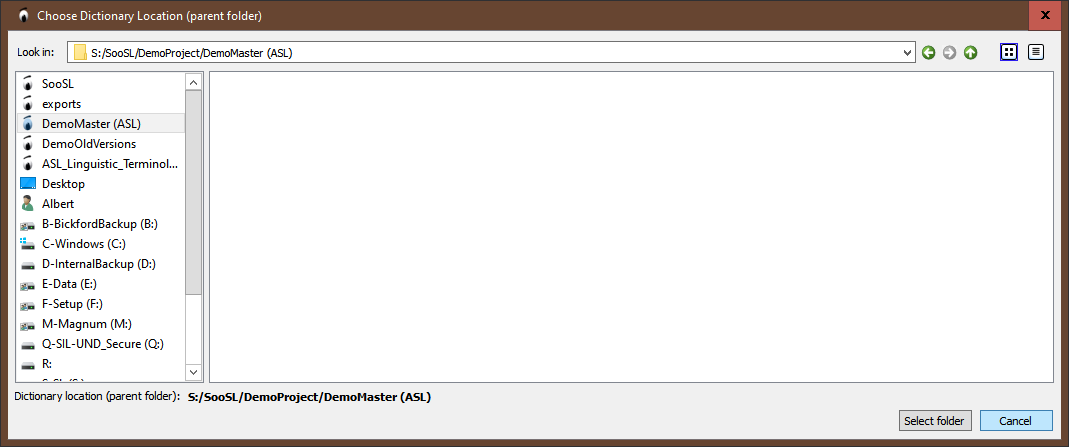
For example, you might want to store the dictionary project someplace else on your hard drive. You might want to store it in a special folder that automatically syncs a spare copy to cloud storage (Dropbox, Google Drive, OneDrive or iCloud). You might even want it on a USB stick so you can easily work with the dictionary project on different computers. (See the help topic about working together on a dictionary project.) Choose the new dictionary location, then click  .
.
If a dictionary with the same folder name already exists in the dictionary location, SooSL will warn you. The Import Dictionary dialog will change. The warning is in red.
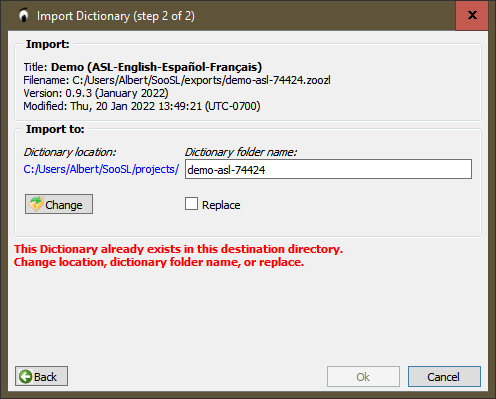
You have three choices:
 checkbox next to Replace.)
checkbox next to Replace.) After you make your choice, click  and you will see a progress dialog while SooSL imports (unpacks) the files. When the import is finished, you will see a small dialog:
and you will see a progress dialog while SooSL imports (unpacks) the files. When the import is finished, you will see a small dialog:
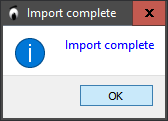
Click  to continue.
to continue.
If the imported dictionary does not open immediately, click ![]() Tools >
Tools > ![]() Open project. Find the dictionary in the folder where you imported it (the Dictionary location), and click
Open project. Find the dictionary in the folder where you imported it (the Dictionary location), and click  .
.
Then you can start reading and studying the signs in the dictionary.
When you are choosing a ZooZL file in the Import Dictionary dialog (above), if you want to see more information about the different ZooZL files, click ![]() Detail View in the top-right corner of the dialog. Detail view shows more columns of information.
Detail View in the top-right corner of the dialog. Detail view shows more columns of information.
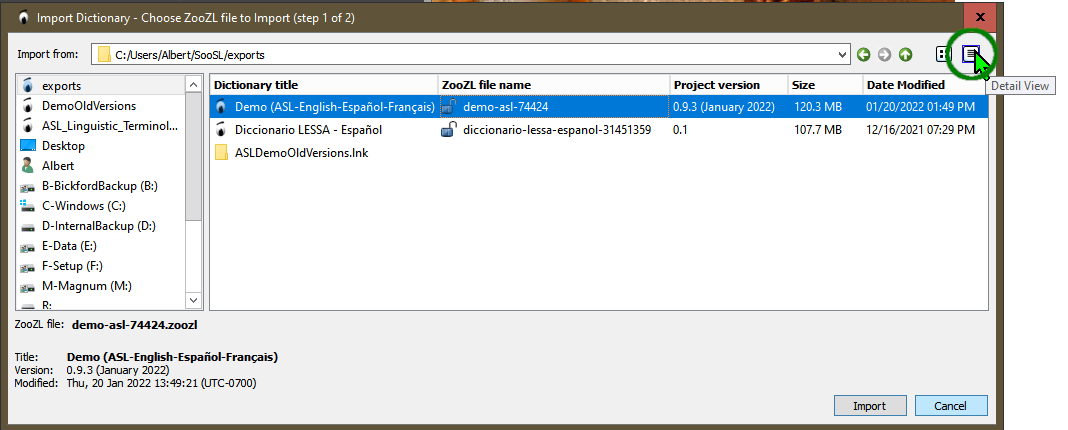
Detail view shows the following information:
The Import Dictionary dialog is special for SooSL, to make it easier to find and open ZooZL files. However, it doesn't give you full access to all files on your computer or on your local network (LAN). To import a dictionary from another computer across a local area network, see this topic.
Created with the Personal Edition of HelpNDoc: Easily create CHM Help documents